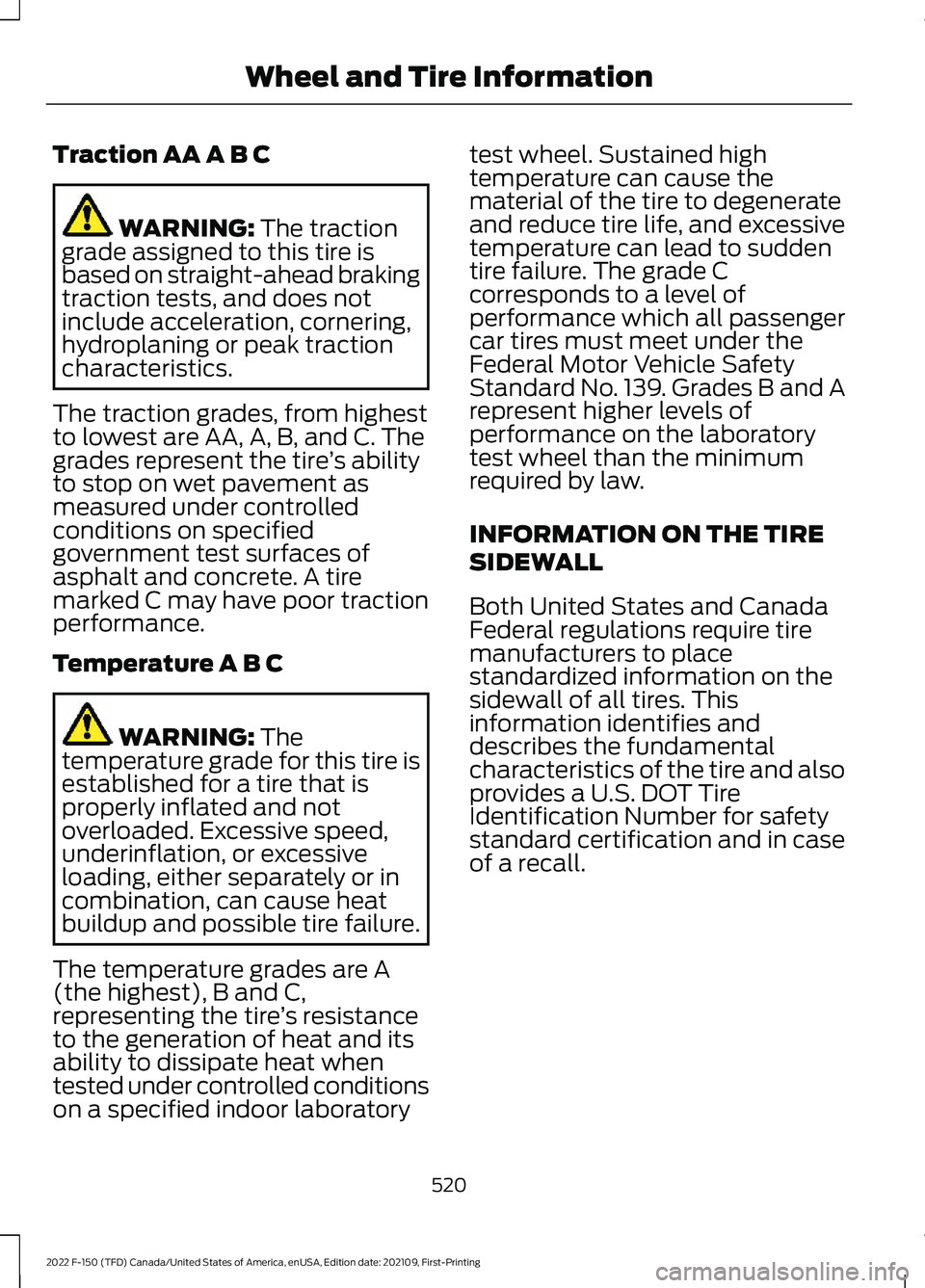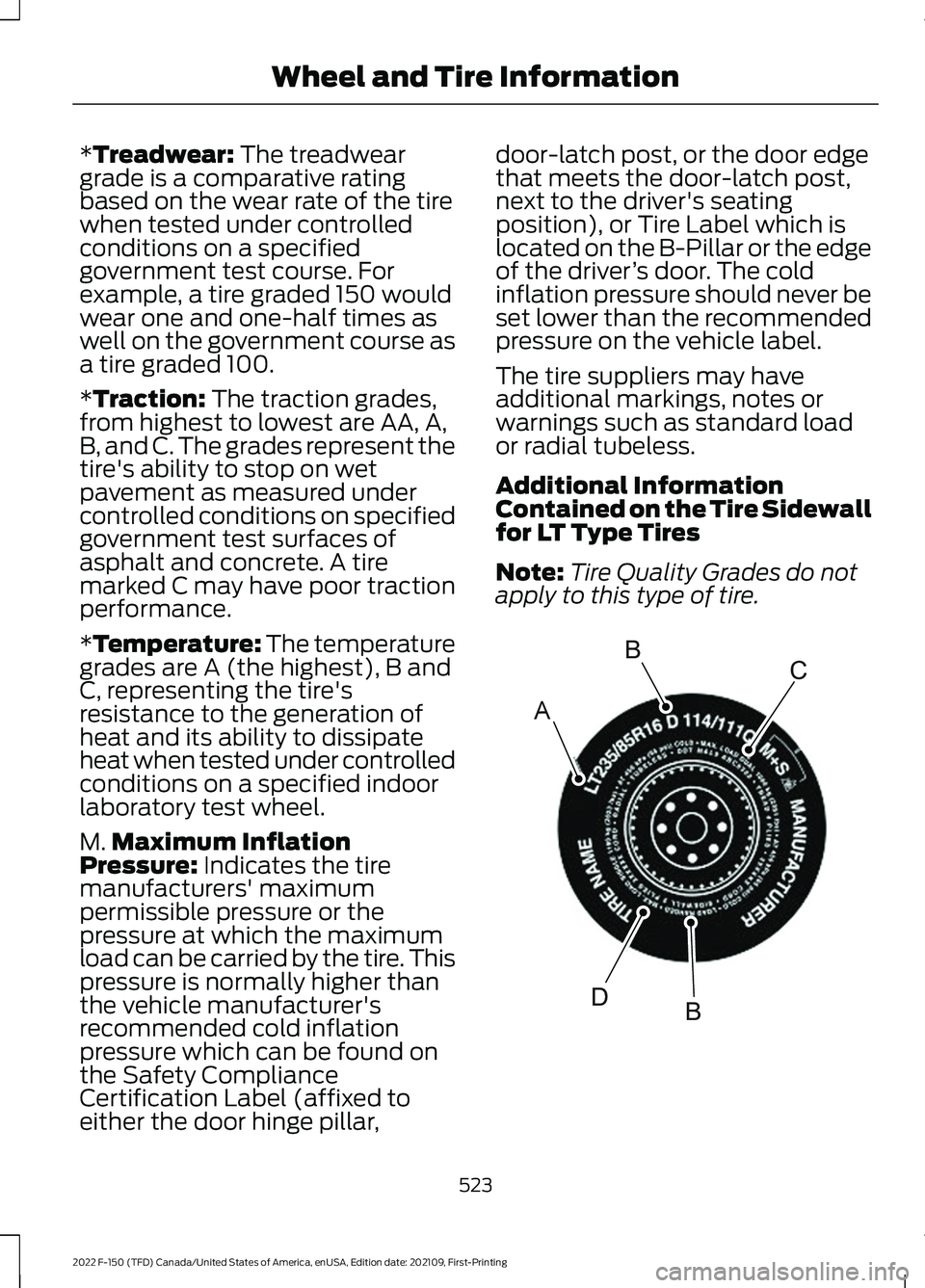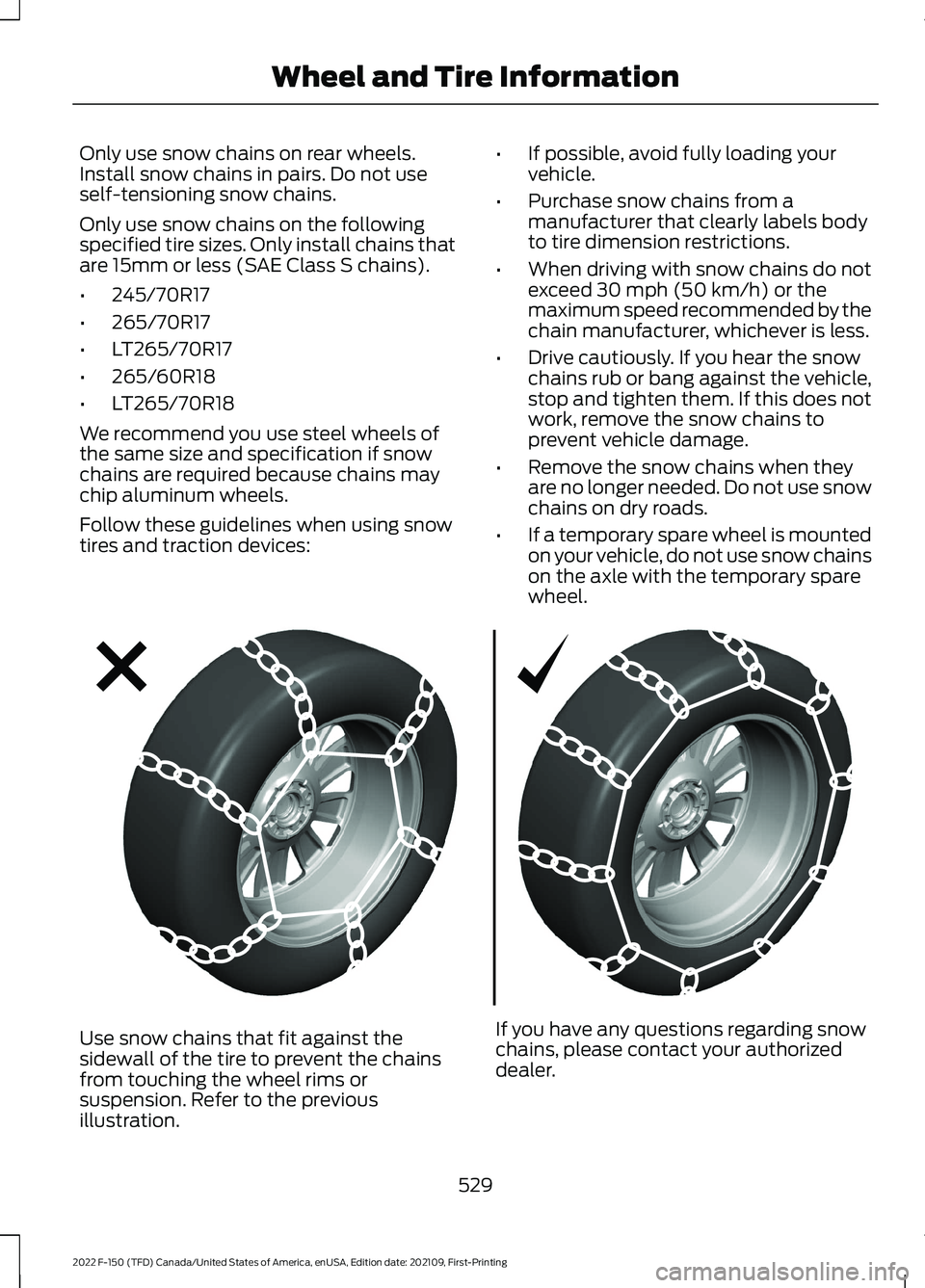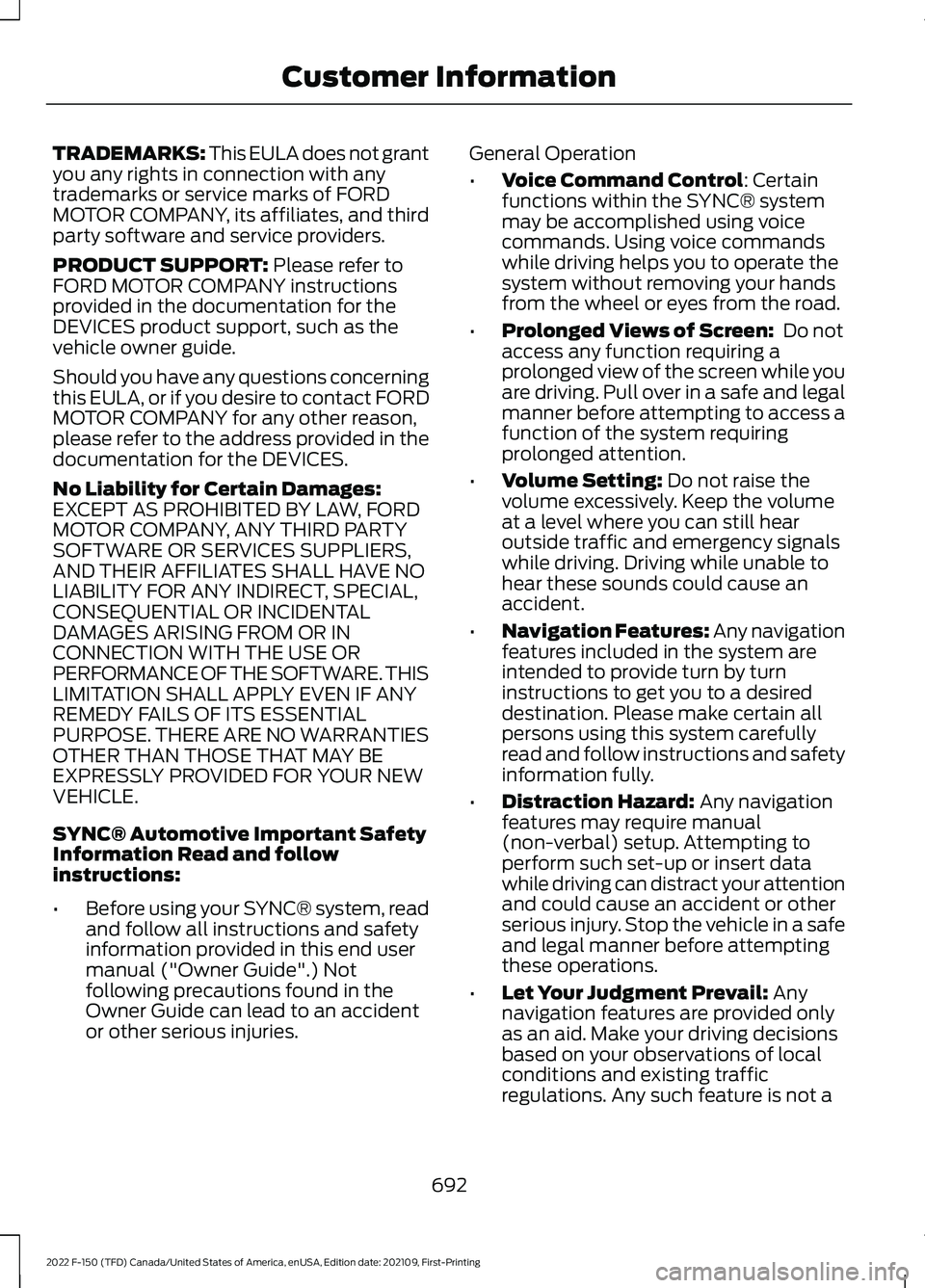2022 FORD F-150 traction
[x] Cancel search: tractionPage 524 of 750

Traction AA A B C
WARNING: The traction
grade assigned to this tire is
based on straight-ahead braking
traction tests, and does not
include acceleration, cornering,
hydroplaning or peak traction
characteristics.
The traction grades, from highest
to lowest are AA, A, B, and C. The
grades represent the tire ’s ability
to stop on wet pavement as
measured under controlled
conditions on specified
government test surfaces of
asphalt and concrete. A tire
marked C may have poor traction
performance.
Temperature A B C WARNING:
The
temperature grade for this tire is
established for a tire that is
properly inflated and not
overloaded. Excessive speed,
underinflation, or excessive
loading, either separately or in
combination, can cause heat
buildup and possible tire failure.
The temperature grades are A
(the highest), B and C,
representing the tire ’s resistance
to the generation of heat and its
ability to dissipate heat when
tested under controlled conditions
on a specified indoor laboratory test wheel. Sustained high
temperature can cause the
material of the tire to degenerate
and reduce tire life, and excessive
temperature can lead to sudden
tire failure. The grade C
corresponds to a level of
performance which all passenger
car tires must meet under the
Federal Motor Vehicle Safety
Standard No. 139. Grades B and A
represent higher levels of
performance on the laboratory
test wheel than the minimum
required by law.
INFORMATION ON THE TIRE
SIDEWALL
Both United States and Canada
Federal regulations require tire
manufacturers to place
standardized information on the
sidewall of all tires. This
information identifies and
describes the fundamental
characteristics of the tire and also
provides a U.S. DOT Tire
Identification Number for safety
standard certification and in case
of a recall.
520
2022 F-150 (TFD) Canada/United States of America, enUSA, Edition date: 202109, First-Printing Wheel and Tire Information
Page 526 of 750

Note:
You may not find this
information on all tires because it
is not required by federal law. Speed rating
Letter
rating
81 mph (130 km/h)
M
87 mph (140 km/h)
N
99 mph (159 km/h)
Q
106 mph (171 km/h)
R
112 mph (180 km/h)
S
118 mph (190 km/h)
T
124 mph (200 km/h)
U
130 mph (210 km/h)
H
149 mph (240 km/h)
V
168 mph (270 km/h)
W
186 mph (299 km/h)
Y
Note: For tires with a maximum
speed capability over 149 mph
(240 km/h), tire manufacturers
sometimes use the letters ZR. For
those with a maximum speed
capability over 186 mph (299
km/h), tire manufacturers always
use the letters ZR.
H. U.S. DOT Tire Identification
Number (TIN): This begins with
the letters DOT and indicates that
the tire meets all federal
standards. The next two numbers
or letters are the plant code
designating where it was
manufactured, the next two are the tire size code and the last four
numbers represent the week and
year the tire was built. For
example, the numbers 317 mean
the 31st week of 1997. After 2000,
the numbers go to four digits. For
example, 2501 means the 25th
week of 2001. The numbers in
between are identification codes
used for traceability. This
information is used to contact
customers if a tire defect requires
a recall.
I.
M+S or M/S:
Mud and Snow, or
AT:
All Terrain, or
AS:
All Season.
J. Tire Ply Composition and
Material Used:
Indicates the
number of plies or the number of
layers of rubber-coated fabric in
the tire tread and sidewall. Tire
manufacturers also must indicate
the ply materials in the tire and the
sidewall, which include steel,
nylon, polyester, and others.
K. Maximum Load: Indicates the
maximum load in kilograms and
pounds that can be carried by the
tire. See the Safety Compliance
Certification Label (affixed to
either the door hinge pillar,
door-latch post, or the door edge
that meets the door-latch post,
next to the driver's seating
position), for the correct tire
pressure for your vehicle.
L. Treadwear, Traction and
Temperature Grades:
522
2022 F-150 (TFD) Canada/United States of America, enUSA, Edition date: 202109, First-Printing Wheel and Tire Information
Page 527 of 750

*Treadwear: The treadwear
grade is a comparative rating
based on the wear rate of the tire
when tested under controlled
conditions on a specified
government test course. For
example, a tire graded 150 would
wear one and one-half times as
well on the government course as
a tire graded 100.
*
Traction: The traction grades,
from highest to lowest are AA, A,
B, and C. The grades represent the
tire's ability to stop on wet
pavement as measured under
controlled conditions on specified
government test surfaces of
asphalt and concrete. A tire
marked C may have poor traction
performance.
*
Temperature: The temperature
grades are A (the highest), B and
C, representing the tire's
resistance to the generation of
heat and its ability to dissipate
heat when tested under controlled
conditions on a specified indoor
laboratory test wheel.
M. Maximum Inflation
Pressure:
Indicates the tire
manufacturers' maximum
permissible pressure or the
pressure at which the maximum
load can be carried by the tire. This
pressure is normally higher than
the vehicle manufacturer's
recommended cold inflation
pressure which can be found on
the Safety Compliance
Certification Label (affixed to
either the door hinge pillar, door-latch post, or the door edge
that meets the door-latch post,
next to the driver's seating
position), or Tire Label which is
located on the B-Pillar or the edge
of the driver
’s door. The cold
inflation pressure should never be
set lower than the recommended
pressure on the vehicle label.
The tire suppliers may have
additional markings, notes or
warnings such as standard load
or radial tubeless.
Additional Information
Contained on the Tire Sidewall
for LT Type Tires
Note: Tire Quality Grades do not
apply to this type of tire. 523
2022 F-150 (TFD) Canada/United States of America, enUSA, Edition date: 202109, First-Printing Wheel and Tire InformationA
BC
BDE142544
Page 533 of 750

Only use snow chains on rear wheels.
Install snow chains in pairs. Do not use
self-tensioning snow chains.
Only use snow chains on the following
specified tire sizes. Only install chains that
are 15mm or less (SAE Class S chains).
•
245/70R17
• 265/70R17
• LT265/70R17
• 265/60R18
• LT265/70R18
We recommend you use steel wheels of
the same size and specification if snow
chains are required because chains may
chip aluminum wheels.
Follow these guidelines when using snow
tires and traction devices: •
If possible, avoid fully loading your
vehicle.
• Purchase snow chains from a
manufacturer that clearly labels body
to tire dimension restrictions.
• When driving with snow chains do not
exceed 30 mph (50 km/h) or the
maximum speed recommended by the
chain manufacturer, whichever is less.
• Drive cautiously. If you hear the snow
chains rub or bang against the vehicle,
stop and tighten them. If this does not
work, remove the snow chains to
prevent vehicle damage.
• Remove the snow chains when they
are no longer needed. Do not use snow
chains on dry roads.
• If a temporary spare wheel is mounted
on your vehicle, do not use snow chains
on the axle with the temporary spare
wheel. Use snow chains that fit against the
sidewall of the tire to prevent the chains
from touching the wheel rims or
suspension. Refer to the previous
illustration.
If you have any questions regarding snow
chains, please contact your authorized
dealer.
529
2022 F-150 (TFD) Canada/United States of America, enUSA, Edition date: 202109, First-Printing Wheel and Tire InformationE292547
Page 660 of 750

ROLLOVER WARNING
WARNING: Utility vehicles have a
significantly higher rollover rate than
other types of vehicles. WARNING:
Vehicles with a higher
center of gravity (utility and four-wheel
drive vehicles) handle differently than
vehicles with a lower center of gravity
(passenger cars). Avoid sharp turns,
excessive speed and abrupt steering in
these vehicles. Failure to drive cautiously
increases the risk of losing control of your
vehicle, vehicle rollover, personal injury
and death. WARNING:
In a rollover crash, an
unbelted person is significantly more
likely to die than a person wearing a
seatbelt. WARNING:
Do not become
overconfident in the ability of four-wheel
drive vehicles. Although a four-wheel
drive vehicle may accelerate better than
a two-wheel drive vehicle in low traction
situations, it won't stop any faster than
two-wheel drive vehicles. Always drive
at a safe speed.
Utility vehicles and trucks handle
differently than passenger cars in the
various driving conditions that are
encountered on streets, highways and
off-road. Utility vehicles and trucks are not
designed for cornering at speeds as high
as passenger cars any more than low-slung
sports cars are designed to perform
satisfactorily under off-road conditions. THE BETTER BUSINESS
BUREAU AUTO LINE
PROGRAM
Your satisfaction is important to Ford
Motor Company and to your dealer. If a
warranty concern has not been resolved
using the three-step procedure outlined
earlier in this chapter in the Getting the
Services you need section, you may be
eligible to participate in the BBB AUTO
LINE program.
The BBB AUTO LINE program consists of
two parts – mediation and arbitration.
During mediation, a representative of the
BBB will contact both you and Ford Motor
Company to explore options for settlement
of the claim. If an agreement is not reached
during mediation or you do not want to
participate in mediation, and if your claim
is eligible, you may participate in the
arbitration process. An arbitration hearing
will be scheduled so that you can present
your case in an informal setting before an
impartial person. The arbitrator considers
the testimony provided and makes a
decision after the hearing.
Disputes submitted to the BBB AUTO LINE
program are usually decided within 40
days after you file your claim with the BBB.
You are not bound by the decision, and
may reject the decision and proceed to
court where all findings of the BBB Auto
Line dispute, and decision, are admissible
in the court action. Should you choose to
accept the BBB AUTO LINE decision, Ford
is then bound by the decision, and must
comply with the decision within 30 days
of receipt of your acceptance letter.
BBB AUTO LINE Application: Using the
information that follows, please call or
write to request a program application.
You will be asked for your name and
address, general information about your
new vehicle, information about your
warranty concerns, and any steps you have
656
2022 F-150 (TFD) Canada/United States of America, enUSA, Edition date: 202109, First-Printing Customer Information
Page 696 of 750

TRADEMARKS: This EULA does not grant
you any rights in connection with any
trademarks or service marks of FORD
MOTOR COMPANY, its affiliates, and third
party software and service providers.
PRODUCT SUPPORT: Please refer to
FORD MOTOR COMPANY instructions
provided in the documentation for the
DEVICES product support, such as the
vehicle owner guide.
Should you have any questions concerning
this EULA, or if you desire to contact FORD
MOTOR COMPANY for any other reason,
please refer to the address provided in the
documentation for the DEVICES.
No Liability for Certain Damages:
EXCEPT AS PROHIBITED BY LAW, FORD
MOTOR COMPANY, ANY THIRD PARTY
SOFTWARE OR SERVICES SUPPLIERS,
AND THEIR AFFILIATES SHALL HAVE NO
LIABILITY FOR ANY INDIRECT, SPECIAL,
CONSEQUENTIAL OR INCIDENTAL
DAMAGES ARISING FROM OR IN
CONNECTION WITH THE USE OR
PERFORMANCE OF THE SOFTWARE. THIS
LIMITATION SHALL APPLY EVEN IF ANY
REMEDY FAILS OF ITS ESSENTIAL
PURPOSE. THERE ARE NO WARRANTIES
OTHER THAN THOSE THAT MAY BE
EXPRESSLY PROVIDED FOR YOUR NEW
VEHICLE.
SYNC® Automotive Important Safety
Information Read and follow
instructions:
• Before using your SYNC® system, read
and follow all instructions and safety
information provided in this end user
manual ("Owner Guide".) Not
following precautions found in the
Owner Guide can lead to an accident
or other serious injuries. General Operation
•
Voice Command Control
: Certain
functions within the SYNC® system
may be accomplished using voice
commands. Using voice commands
while driving helps you to operate the
system without removing your hands
from the wheel or eyes from the road.
• Prolonged Views of Screen:
Do not
access any function requiring a
prolonged view of the screen while you
are driving. Pull over in a safe and legal
manner before attempting to access a
function of the system requiring
prolonged attention.
• Volume Setting:
Do not raise the
volume excessively. Keep the volume
at a level where you can still hear
outside traffic and emergency signals
while driving. Driving while unable to
hear these sounds could cause an
accident.
• Navigation Features:
Any navigation
features included in the system are
intended to provide turn by turn
instructions to get you to a desired
destination. Please make certain all
persons using this system carefully
read and follow instructions and safety
information fully.
• Distraction Hazard:
Any navigation
features may require manual
(non-verbal) setup. Attempting to
perform such set-up or insert data
while driving can distract your attention
and could cause an accident or other
serious injury. Stop the vehicle in a safe
and legal manner before attempting
these operations.
• Let Your Judgment Prevail:
Any
navigation features are provided only
as an aid. Make your driving decisions
based on your observations of local
conditions and existing traffic
regulations. Any such feature is not a
692
2022 F-150 (TFD) Canada/United States of America, enUSA, Edition date: 202109, First-Printing Customer Information
Page 733 of 750

Hitches............................................................399
Hooking Up a Trailer Using a
Weight-Distributing Hitch......................... 399
Hood Lock See: Opening and Closing the Hood..........482
Horn...................................................................139
How Does 911 Assist Work..........................85
How Does Active Park Assist Work.......325
How Does Adaptive Cruise Control With Stop and Go Work.....................................331
How Does a Hybrid Electric Vehicle Work................................................................241
How Does Auto Hold Work......................297
How Does Blind Spot Information System Work
..............................................368
How Does BlueCruise Work.....................344
How Does Cross Traffic Alert Work...............................................................372
How Does Drive Mode Control Work..............................................................350
How Does Driver Alert Work....................386
How Does Easy Entry and Exit Work................................................................110
How Does Four-Wheel Drive Work.......269
How Does Four-Wheel Drive Work - Raptor...........................................................269
How Does Hill Descent Control Work..............................................................309
How Does Hill Start Assist Work...........296
How Does On-Board Scale Work..........420
How Does Pre-Collision Assist Work
...............................................................375
How Does Reverse Braking Assist Work
...............................................................292
How Does Smart Hitch Work...................418
How Does Stability Control Work.........300
How Does the 360 Degree Camera Work................................................................321
How Does the Electronic Locking Differential Work
.......................................279
How Does the Electronic Locking Differential Work - Raptor
.....................279
How Does the Garage Door Opener Work..............................................................205
How Does the Lane Keeping System Work...............................................................361
How Does the Personal Safety System Work.................................................................69 How Does the Rear Occupant Alert
System Work
..............................................202
How Does the Safety Canopy ™
Work...................................................................71
How Does Traction Control Work.........298
How Does Trailer Backup Assistance Work...............................................................422
How Does Trailer Hitching Assistance Work...............................................................415
How Does Trailer Reverse Guidance Work...............................................................437
How Does Trailer Sway Control Work...............................................................414
How Do Personal Profiles Work.............628
How Do the Front Airbags Work...............70
How Do the Knee Airbags Work.................71
How Do the Side Airbags Work.................70
Hybrid Display Information.......................176 How Does EV Coach Work.............................. 176
What Is EV Coach............................................... 176
Hybrid Electric Vehicle Driving Characteristics............................................241
Hybrid Electric Vehicle Indicators
...........241
Hybrid Electric Vehicle Information.......241 Eco Idle.................................................................. 242
Eco Idle – Troubleshooting............................ 243
Hybrid Electric Vehicle Information – Troubleshooting............................................ 242
Hybrid Electric Vehicle Information – Troubleshooting........................................242
Hybrid Electric Vehicle Information – Frequently Asked Questions..................... 242
I
Identifying Fuse Types...............................481
Identifying the Audio Unit........................603
Identifying the Auxiliary Switch Wiring............................................................637
Identifying the Climate Control Unit..................................................................181
Ignition Switch
...............................................231
Inflating the Tires.........................................532
Information On Demand Screen - Vehicles With: 12.3 Inch Screen............616
Information on the Tire Sidewall...........520
Inspecting the Tire for Damage..............533
Inspecting the Tire for Wear....................533
729
2022 F-150 (TFD) Canada/United States of America, enUSA, Edition date: 202109, First-Printing Index
Page 743 of 750

Switching the Heated Steering Wheel
On and Off - Vehicles With: Heated
Steering Wheel...........................................139
Switching the Heated Wiper Park On and Off...................................................................182
Switching the Lane Keeping System Mode.............................................................362
Switching the Lane Keeping System On and Off
..........................................................362
Switching the Rear Interior Lamps On and Off..........................................................158
Switching Traction Control On and Off..................................................................298
Switching Trail Control On and Off - Raptor...........................................................303
Switching Trailer Backup Assistance On and Off
.........................................................426
Switching Trailer Hitching Assistance On and Off..........................................................416
Switching Trailer Reverse Guidance On and Off
.........................................................440
Switching Trailer Sway Control On and Off...................................................................414
Switching Trail Turn Assist On and Off...................................................................307
Switching Utility Idle On and Off - Vehicles With: Flip Key
.............................214
Symbols Glossary..........................................24
Symbols Used on Your Vehicle.................24
T
Tachometer....................................................168
Tailgate Anchor Points..............................395 Locating the Tailgate Anchor Points..........395
Tailgate Anchor Point Load
Capacities........................................................ 395
Tailgate Precautions......................................111
Tailgate Step....................................................112 Accessing the Tailgate Step............................. 112
Stowing the Tailgate Step................................ 113
Tailgate
...............................................................111
Bed Extender......................................................... 113
Closing the Tailgate............................................. 117
Opening the Tailgate........................................... 111
Tailgate Step.......................................................... 112
Tailgate – Troubleshooting............................. 123Tailgate – Troubleshooting.......................123
Tailgate – Frequently Asked
Questions.......................................................... 124
Tailgate – Information Messages.................123
Tailgate – Warning Lamps.............................. 123
Tailgate Work Surface..................................115
Team RS
.............................................................19
Technical Specifications See: Capacities and Specifications............558
Temporary Neutral Mode.........................264 Entering Temporary Neutral Mode.............264
Exiting Temporary Neutral Mode.................265
Temporary Neutral Mode
Limitations...................................................... 264
What Is Temporary Neutral Mode...............264
The Better Business Bureau Auto Line Program.......................................................656
The Mediation and Arbitration Program........................................................657
Tire Care..........................................................532
Tire Pressure Monitoring System Limitations...................................................537
Tire Pressure Monitoring System Overview......................................................536
Tire Pressure Monitoring System Precautions.................................................537
Tire Pressure Monitoring System..........536 Tire Pressure Monitoring System –
Troubleshooting............................................. 541
Tire Pressure Monitoring System – Troubleshooting.........................................541
Tire Pressure Monitoring System – Information Messages................................ 542
Tire Pressure Monitoring System – Warning Lamps................................................................ 541
Tire Replacement Requirements..........526
Tire Rotation
..................................................534
Towing a Trailer Limitations....................404
Towing a Trailer Precautions...................403
Towing a Trailer............................................403 Towing a Trailer – Troubleshooting...........408
Towing Weights and Dimensions...............406
Towing a Trailer – Troubleshooting.......................................408
Towing a Trailer – Information Messages........................................................ 408
739
2022 F-150 (TFD) Canada/United States of America, enUSA, Edition date: 202109, First-Printing Index